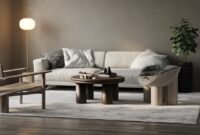Introduction: Why the Center Table is the Focal Point of Your Living Room
The center table is often considered the focal point of the living room. It is not only a functional piece of furniture but also a decorative element that ties the room together. The right center table can enhance the overall look and feel of the space, while the wrong one can disrupt the harmony of the room. Therefore, it is important to carefully consider various factors before choosing a center table for your living room.
Consider Your Room Size and Shape Before Choosing a Center Table
Before selecting a center table, it is crucial to take into account the size and shape of your living room. A large living room can accommodate a bigger center table, while a smaller living room may require a smaller one. The size of the center table should be proportionate to the size of the room to ensure that it does not overwhelm or underwhelm the space. Additionally, the shape of the center table should complement the shape of the room. For instance, a rectangular center table may work well in a long and narrow living room, while a round or oval table can soften the look of a square room.
Materials Matter: Wood, Glass, Metal or Marble?
The material of the center table can greatly impact the overall look and feel of your living room. Wood is a classic and versatile option that can suit various styles of decor. It adds warmth and a touch of elegance to the space. Glass and metal center tables, on the other hand, can add a modern and sleek touch to the room. They are perfect for contemporary or minimalist interiors. Marble is a luxurious option that can elevate the look of your living room. It exudes sophistication and can be a statement piece in itself. However, it is important to consider the durability and maintenance requirements of each material before making a decision.
Functionality: Choose a Center Table that Suits Your Lifestyle
When choosing a center table, it is important to consider how you will use it. If you have kids or pets, a sturdy and durable option may be the best choice. You want a table that can withstand the wear and tear of everyday use. Additionally, if you entertain often, a larger center table with ample surface space may be necessary. This will allow you to comfortably serve drinks and snacks to your guests. On the other hand, if you primarily use your living room for relaxation and quiet activities, a smaller and more minimalist center table may be sufficient.
Style Matters: From Contemporary to Traditional, Find Your Perfect Match
Your center table should complement the overall style of your living room. Whether you have a contemporary, traditional, or eclectic decor, there are center tables available in a variety of styles to suit your taste. For a contemporary look, opt for a center table with clean lines and minimalistic design. If you have a traditional decor, a center table with intricate details and ornate carvings may be more suitable. It is important to choose a style that harmonizes with the rest of your furniture and accessories to create a cohesive and visually appealing space.
Color and Finish: How to Choose a Center Table that Complements Your Decor
The color and finish of your center table should complement the rest of your living room decor. Consider the color of your walls, furniture, and accessories when choosing a center table. If you have a neutral color scheme, you can opt for a center table in a bold or vibrant color to add a pop of color to the room. On the other hand, if you have a colorful decor, a center table in a neutral or muted tone can help balance the overall look. The finish of the center table should also be taken into consideration. A glossy finish can add a touch of elegance, while a matte finish can create a more rustic or casual look.
Height Matters: Finding the Right Height for Your Center Table
The height of your center table is an important factor to consider for both aesthetic and functional reasons. The height of the table should be proportional to the height of your seating. A general rule of thumb is to choose a center table that is the same height or slightly lower than your sofa. This ensures that the table is easily accessible and comfortable to use. If the table is too high, it can be awkward to reach for items on the table. On the other hand, if the table is too low, it can be uncomfortable to use and may not provide enough surface space for your needs.
Shape and Design: Round, Square, Rectangular or Oval?
The shape and design of your center table can greatly impact the flow and functionality of your living room. Round and oval center tables can soften the look of a room and create a more organic and fluid feel. They are also great options for small spaces as they do not have sharp corners that can take up valuable space. Square and rectangular center tables, on the other hand, can add structure and create a more formal and symmetrical look. They are ideal for larger living rooms and can provide ample surface space for various activities.
Storage Options: Incorporating Storage into Your Center Table
If you need extra storage in your living room, consider a center table with built-in storage options. Some center tables come with drawers, shelves, or hidden compartments that can help you keep your living room organized and clutter-free. This is especially useful if you have limited storage space in your home. You can use the storage compartments to store remote controls, magazines, books, or other small items that you want to keep within easy reach. However, it is important to ensure that the storage options do not compromise the overall look and functionality of the center table.
Maintenance and Care: Tips for Keeping Your Center Table Looking New
Proper maintenance and care can help your center table last for years to come. Use coasters to prevent water rings and scratches on the surface of the table. This is especially important if you frequently place drinks or hot items on the table. Clean your center table regularly with a soft cloth and mild cleaner to remove dust and dirt. Avoid using harsh chemicals or abrasive cleaners as they can damage the finish of the table. Additionally, it is important to periodically check and tighten any loose screws or joints to ensure the stability and longevity of the table. By following these simple tips, you can keep your center table looking new and beautiful for years to come.




